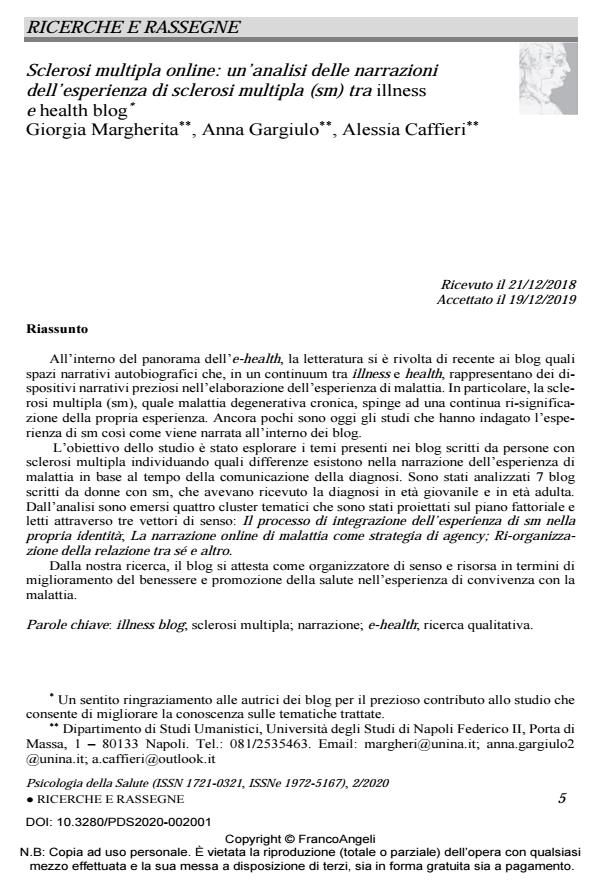Sclerosi multipla online: un’analisi delle narrazioni dell’esperienza di sclerosi multipla (sm) tra illness e health blog
Titolo Rivista PSICOLOGIA DELLA SALUTE
Autori/Curatori Giorgia Margherita, Anna Gargiulo, Alessia Caffieri
Anno di pubblicazione 2020 Fascicolo 2020/2
Lingua Italiano Numero pagine 20 P. 5-24 Dimensione file 308 KB
DOI 10.3280/PDS2020-002001
Il DOI è il codice a barre della proprietà intellettuale: per saperne di più
clicca qui
Qui sotto puoi vedere in anteprima la prima pagina di questo articolo.
Se questo articolo ti interessa, lo puoi acquistare (e scaricare in formato pdf) seguendo le facili indicazioni per acquistare il download credit. Acquista Download Credits per scaricare questo Articolo in formato PDF

FrancoAngeli è membro della Publishers International Linking Association, Inc (PILA)associazione indipendente e non profit per facilitare (attraverso i servizi tecnologici implementati da CrossRef.org) l’accesso degli studiosi ai contenuti digitali nelle pubblicazioni professionali e scientifiche
All’interno del panorama dell’e-health, la letteratura si è rivolta di recente ai blog quali spazi narrativi autobiografici che, in un continuum tra illness e health, rappresentano dei dispositivi narrativi preziosi nell’elaborazione dell’esperienza di malattia. In particolare, la sclerosi multipla (sm), quale malattia degenerativa cronica, spinge ad una continua risignificazione della propria esperienza. Ancora pochi sono oggi gli studi che hanno indagato l’esperienza di sm così come viene narrata all’interno dei blog. L’obiettivo dello studio è stato esplorare i temi presenti nei blog scritti da persone con sclerosi multipla individuando quali differenze esistono nella narrazione dell’esperienza di ma-lattia in base al tempo della comunicazione della diagnosi. Sono stati analizzati 7 blog scritti da donne con sm, che avevano ricevuto la diagnosi in età giovanile e in età adulta. Dall’analisi sono emersi quattro cluster tematici che sono stati proiettati sul piano fattoriale e letti attraverso tre vettori di senso: Il processo di integrazione dell’esperienza di sm nella propria identità; La narrazione online di malattia come strategia di agency; Riorganizzazione della relazione tra sé e altro. Dalla nostra ricerca, il blog si attesta come organizzatore di senso e risorsa in termini di miglioramento del benessere e promozione della salute nell’esperienza di convivenza con la malattia. .
Parole chiave:Illness blog; sclerosi multipla; narrazione; e-health; ricerca qualitativa
- The Psychological Health and Professional Well-being of Operators
Working with Forced Migrants in Italy: A Cross-sectional
Epidemiological Study Francesca Tessitore, Alessia Caffieri, Claudia Giordano, Giovanna Celia, Giorgia Margherita, in Current Psychiatry Research and Reviews /2024 pp.270
DOI: 10.2174/0126660822272705231121111221
Giorgia Margherita, Anna Gargiulo, Alessia Caffieri, Sclerosi multipla online: un’analisi delle narrazioni dell’esperienza di sclerosi multipla (sm) tra illness e health blog in "PSICOLOGIA DELLA SALUTE" 2/2020, pp 5-24, DOI: 10.3280/PDS2020-002001